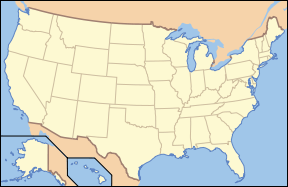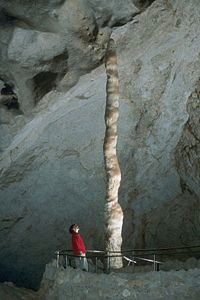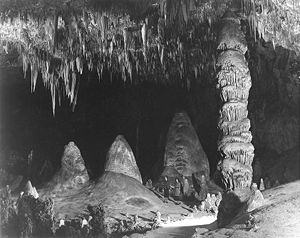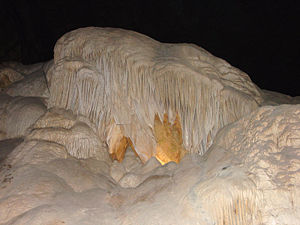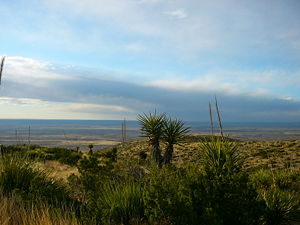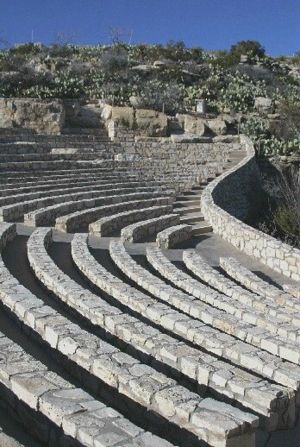Carlsbad Caverns National Park
2008/9 Schools Wikipedia Selection. Related subjects: North American Geography
| Carlsbad Caverns National Park | |
|---|---|
| IUCN Category II ( National Park) | |
| Location | Eddy County, New Mexico, U.S. |
| Nearest city | Carlsbad |
| Coordinates | |
| Area | 46,766.45 acres (46,427.26 federal) 189.26 km² |
| Established | May 14, 1930 |
| Visitors | 407,367 (in 2006) |
| Governing body | National Park Service |
| Carlsbad Caverns National Park* | |
|---|---|
| UNESCO World Heritage Site | |
 |
|
| State Party | |
| Type | Natural |
| Criteria | vii, viii |
| Reference | 721 |
| Region** | Europe and North America |
| Inscription history | |
| Inscription | 1995 (19th Session) |
| * Name as inscribed on World Heritage List. ** Region as classified by UNESCO. |
|
Carlsbad Caverns National Park is a United States National Park located in the Guadalupe Mountains in southeastern New Mexico. Visitors can hike into the interior rooms on their own via the natural entrance, or take an elevator (the exit for everyone) directly down into the centre of the public cave area.
Approximately two thirds of the park has also been set aside as a wilderness area, helping to ensure no future changes will be made to the habitat.
Peak visitation typically occurs on the weekends following Memorial Day and the 4th of July. The park entrance is located on US Highway 62/180 approximately 18 miles (29 km) southwest of Carlsbad, New Mexico. The park participates in the Junior Ranger Program.
Geology
For detail on the area's geology, see Delaware Basin.
History
Jim White explored many of the rooms and gave them their names, including the Big Room, New Mexico Room, King's Palace, Queen's Chamber, Papoose Room, and Green Lake Room. He also named many of the cave's more prominent formations, such as the Totem Pole, Witch's Finger, Giant Dome, Bottomless Pit, Fairyland, Iceberg Rock, Temple of the Sun, and Rock of Ages.
Carlsbad, the town, and, thus, Carlsbad Caverns National Park, supposedly take their name from Karlovy Vary (Carlsbad), Czech Republic, meaning literally, Charles' Baths, in German.
Named rooms
Balloon Ballroom
located in the ceiling above the main entrance corridor, this small room was first accessed by tying a rope to a bunch of balloons and floating them up into the passage.
Bat Cave
a large, unadorned rocky passage connected to the main entrance corridor that was mined for bat guano in the early 20th century. The majority of the cave's bat population lives in this portion of the cave.
Bell Cord Room
named for a long, narrow stalactite coming through a hole in the ceiling, resembling the rope coming through a church steeple to ring the bell. This room is located at the end of the Left Hand Tunnel.
Bifrost Room
discovered in 1982, it is located in the ceiling above Lake of the Clouds. Its name refers to a Norse myth about a world in the sky that was accessed from Earth by a rainbow. The room was given this name because of its location above the Lake of the Clouds and its colorful oxide-stained formations.
Big Room or The Hall of the Giants
the largest chamber in Carlsbad Caverns, with a floor space of 33,210 m² (357,469 sq ft).
Chocolate High
a maze of small passages totaling nearly a mile in combined length, discovered in 1993 above a mud-filled pit in the New Mexico Room known as Chocolate Drop.
Green Lake Room
the uppermost of the "Scenic Rooms", it is named for a deep, malachite-colored pool in the corner of the room. In the 1940s, when the military was testing the feasibility of Carlsbad Cavern as an emergency fallout shelter, the Green Lake was used to look for ripples caused by a nuclear bomb test many miles away. None appeared.
Guadalupe Room
discovered by a park ranger in 1966, this is the second largest room in Carlsbad Caverns. It is known for its dense collection of "soda straw" stalactites.
Hall of the White Giant
a large chamber containing a large, white stalagmite. Rangers regularly lead special wild cave tours to this location.
King's Palace
the first of four chambers in a wing known as the "scenic rooms", it is named for a large castle-like formation in the centre of the room. The Bashful Elephant formation can be found here.
Lake of the Clouds
the lowest known point in the cave. It is located in a side passage off the Left Hand Tunnel. It is named for its large lake containing globular, cloud-like rock formations that formed under water when the lake level was much higher.
Left Hand Tunnel
a long, straight passage marked by deep fissures in the floor. These fissures are not known to lead anywhere. The Left Hand Tunnel leads to the Lake of the Clouds and the Bell Cord Room.
Mystery Room
A small room located in the lower part of the cave
New Mexico Room
located adjacent to the Queen's Chamber and accessed by means of a short slope.
New Section
a section of fissures east of the White Giant formation and parallelling the Bat Cave. New discoveries are still being made in this section.
Papoose Room
located between the King's Palace and Queen's Chamber.
Queen's Chamber
widely regarded as the most beautiful and scenic area of the cave. Jim White's lantern went out in this chamber while exploring and was in the dark for over a half hour.
Spirit World
Located in the ceiling of the Big Room, this area is filled with white stalagmites that resembled angels to the room's discoverers.
Talcum Passage
a room located in Lower Cave where the floor is coated with gypsum dust.
The Rookery
one of the larger rooms in Lower Cave. A large number of cave pearls are found in this area.
Underground Lunchroom
Located in the Big Room at the head of the Left Hand Tunnel. It contains a cafeteria that was built in the 1950s, and is where the elevators from the visitor centre exit into the cave.
Recent exploration
In 1985 a very distinctive method of exploration was invented. In a dome area 255 ft (77.7 m) above the Big Room floor not far from the Bottomless Pit a stalagmite leaned out. Using a balsa wood loop with helium-filled balloons attached, the explorers--after several tries over several years--floated a light weight cord that snagged the target stalagmite. Once the light weight cord was in position up, over, and back to the ground, a climbing rope was pulled into position, and the explorers ascended into what they named The Spirit World. A similar, smaller room was found in the main entrance corridor, and was named Balloon Ballroom in honour of this technique.
In 1993, a series of small passages totaling nearly a mile in combined length was found in the ceiling of the New Mexico Room. Named "Chocolate High", it was the largest discovery in the cave since the Guadalupe Room was found in 1966.
Lechuguilla Cave, another cave in the park discovered in 1986, is the focus of much current cave exploration at the park. It has been mapped to a depth of 489 m, making it the deepest limestone cave in the U.S. The entrance is located in an old mining pit called Misery Hole in an obscure corner of the park. It is not accessible to the general public, and the exact location of Misery Hole is kept relatively hidden in an attempt to preserve the cave in its most undisturbed state.
The Bottomless Pit was originally said to have no bottom. Stones were tossed into it, but no sound of the stones striking the bottom was heard. Later exploration revealed that the bottom was about 140 feet (40m) deep and covered with soft dirt. The stones made no sound when they struck the bottom because they were lodged in the soft soil.
Bats
Sixteen species of bats live in the park, including a large number of Mexican Free-tailed Bats. It is estimated that the population of Mexican Free-tailed Bats once numbered in the millions but has declined drastically in modern times. The cause of this decline is unknown but the pesticide DDT is often listed as a primary cause. Populations appear to be on the increase in recent years but are nowhere near the levels that were once historically present.
Many techniques have been used to estimate the bat population in the cave. The various techniques used point to a current population peak of several hundred thousand when the young pups are flying in the fall.
